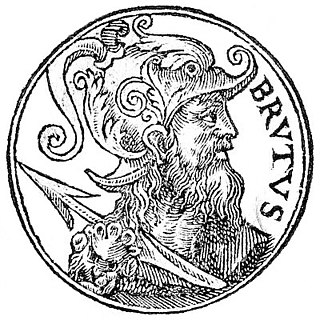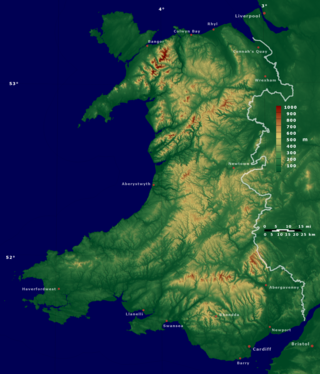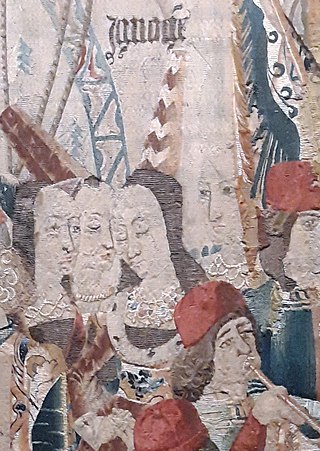
Uther Pendragon (Brittonic), also known as King Uther, was a legendary King of the Britons and father of King Arthur.

Brutus, also called Brute of Troy, is a mythical British king. He is described as a legendary descendant of the Trojan hero Aeneas, known in medieval British legend as the eponymous founder and first king of Britain. This legend first appears in the Historia Brittonum, an anonymous 9th-century historical compilation to which commentary was added by Nennius, but is best known from the account given by the 12th-century chronicler Geoffrey of Monmouth in his Historia Regum Britanniae.

Corineus, in medieval British legend, was a prodigious warrior, a fighter of giants, and the eponymous founder of Cornwall.

Cambria is a name for Wales, being the Latinised form of the Welsh name for the country, Cymru. The term was not in use during the Roman or the early medieval period. After the Anglo-Saxon settlement of much of Britain, a territorial distinction developed between the new Anglo-Saxon kingdoms and the remaining Celtic British kingdoms. Latin being the primary language of scholarship in Western Christendom, medieval writers commonly used either the older term Britannia, as the territory still inhabited by Britons, or Wallia, a term derived from Old English, to refer to Wales. The term Cambria is first attested in Geoffrey of Monmouth in the 12th century as an alternative to both of these, since Britannia was now ambiguous and Wallia a foreign import, but remained rare until late in the Middle Ages.

Locrinus was a legendary king of the Britons, as recounted by the 12th-century chronicler Geoffrey of Monmouth in his Historia Regum Britanniae. He came to power in 1125BC.

Albanactus, according to Geoffrey of Monmouth, was the founding king of Albania or Albany. He is in effect Geoffrey's eponym for Scotland. His territory was that north of the Humber estuary. This myth was then taken up by Giraldus Cambrensis.
Humber the Hun was a legendary king of so-called "Huns" who, according to Geoffrey of Monmouth's pseudohistorical chronicle Historia Regum Britanniae, invaded the British Isles in about the 12th century BC from Scythia. His people successfully conquered Alba but he himself was drowned in the river named Humber after him during his campaign against Southern Britain. His descendants became the List of legendary kings of Pictland.
Gwendolen, also known as Gwendolin, or Gwendolyn was a legendary ruler of ancient Britain. She came to power in 1115BC.
Maddan was a legendary king of the Britons as accounted by Geoffrey of Monmouth. He came to power in 1100BC. He was the son of King Locrinus and Queen Gwendolen, who both ruled Britain separately.

Gurgustius was a legendary king of the Britons as accounted by Geoffrey of Monmouth. He came to power in 788BC.
Dyfnwal Moelmud was accounted as an early king and lawmaker among the Welsh, credited with the codification of their standard units of measure. He also figures as a legendary king of the Britons in Geoffrey of Monmouth's pseudohistorical History of the Kings of the Britons.

Historia regum Britanniae, originally called De gestis Britonum, is a pseudohistorical account of British history, written around 1136 by Geoffrey of Monmouth. It chronicles the lives of the kings of the Britons over the course of two thousand years, beginning with the Trojans founding the British nation and continuing until the Anglo-Saxons assumed control of much of Britain around the 7th century. It is one of the central pieces of the Matter of Britain.

In Arthurian legend, Gorlois of Tintagel was the Duke of Cornwall. He was the first husband of King Arthur's mother Igraine and the father of her daughters, Arthur's half-sisters. Her second husband was Uther Pendragon, the High King of Britain and Arthur's father, who marries her after killing him.

Dionotus was a legendary king of Cornwall in Geoffrey of Monmouth's Historia regum Britanniae, an account of the rulers of Britain based on ancient Welsh sources and disputed by many historians. Dionotus succeeding his brother Caradocus, and was regent of Britain during the campaigns in Gaul of Emperor Magnus Maximus. The curious thing about this king is that the Welsh chronicles, which parallel most of Geoffrey of Monmouth's book, do not mention this king by name. However, Geoffrey uses Latin versions of Welsh names so he could be referring to Dynod, duke of Cornwall, or Anwn Dynod, Maximus's own son.
Logres is King Arthur's realm in the Matter of Britain. The geographical area referred to by the name is south and eastern England. However, Arthurian writers such as Chrétien de Troyes and Wolfram von Eschenbach have differed in their interpretations of this.

Innogen is a character in the Historia Regum Britanniae and subsequent medieval British pseudo-history. She was said to have been a Greek princess, the daughter of King Pandrasus, and to have become Britain's first Queen consort as the wife of Brutus of Troy, the purported first king of Britain who was said to have lived around the 12th century BC. Her sons Locrinus, Camber, and Albanactus went on to rule Loegria, Cambria, and Alba respectively.

Hafren is a legendary British princess who was drowned in the River Severn by her repudiated stepmother Gwendolen. The legend appears in Geoffrey of Monmouth's pseudohistorical chronicle Historia Regum Britanniae. According to Geoffrey, Hafren is the eponym of the Severn, which bears one of Britain's most ancient river names.

Lloegyr is the medieval Welsh name for a region of Britain (Prydain). The exact borders are unknown, but some modern scholars hypothesize it ran south and east of a line extending from the Humber Estuary to the Severn Estuary, exclusive of Cornwall and Devon. The people of Lloegyr were called Lloegyrwys without distinction of ethnicity, the term applying to both Britons and Anglo-Saxons.
Bledric ap Custennin was a 6th- and 7th-century ruler of Dumnonia.














